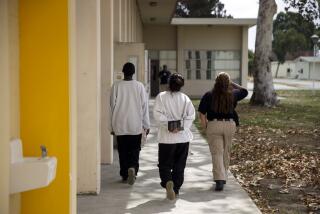Los Pinos: Is It Time to Break Camp?
For the nearly 40 people gathered Saturday morning at the Corona Library, it was easy to agree that the Los Pinos Conservation Camp for juvenile offenders has done a lot of good over the years.
But that didn’t mean all present agreed on the fate of 59 acres of Cleveland National Forest used by Orange County as a detention facility for 16- to 18-year-old boys. The lease for the 125-bed youth camp, which has been in operation for nearly 30 years, expires at the end of 2001, and there is some question about whether U.S. Forest Service officials will renew it.
Saturday’s meeting, which forest officials stressed was just an opportunity to listen to public views, begins what will be a lengthy review of the facilities.
Deputy Ranger Clem Degrosa said that no further construction will be allowed on the land, putting an end to speculation that a local Native American tribe might build a casino there.
Several tribes have expressed interest in the land, which contains a major Native American archeological site.
*
David Belardes, chairman of the Juaneno Band of Mission Indians, said the land was the ancestral home of his people and has special significance. “I have mixed feelings,” he told the group. “We need land because we are a landless tribe. On the other hand, I see the need for this facility.”
However, his tribal manager, Joan Perry, said she believes they have waited long enough. “We’ve gone, what, 205, 225 years without land?” she said.
But camp supporters said the Orange County Probation program has been too successful to abandon.
In a presentation about the work done with teens at Los Pinos, acting Orange County Chief Probation Officer John B. Robinson explained the educational and counseling programs and emphasized that only youthful offenders who commit nonviolent crimes are sent to the camp. Robinson also addressed concerns about “walkaways” from the minimum-security facility, saying they are almost always picked up near their homes within days of leaving.
Orange County officials have invested about $8 million in the camp since 1970 and estimated it would cost about $25 million to buy land and build a facility.
“We have a program here that works,” said Wayne J. Quint Jr., president of the Assn. of Orange County Deputy Sheriffs, who represented his 1,400-member organization. “I hope this lease gets extended for another 100 years. When it comes to these kids, you will pay now or you will pay later.”
More to Read
Sign up for Essential California
The most important California stories and recommendations in your inbox every morning.
You may occasionally receive promotional content from the Los Angeles Times.











